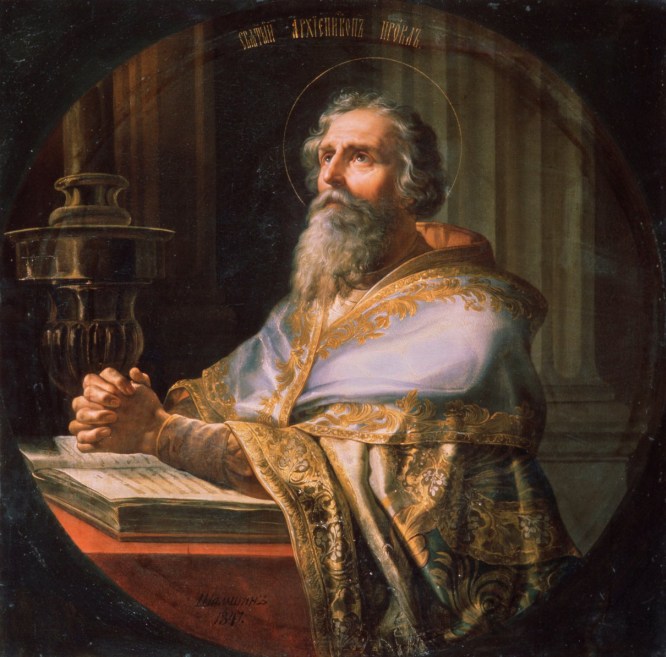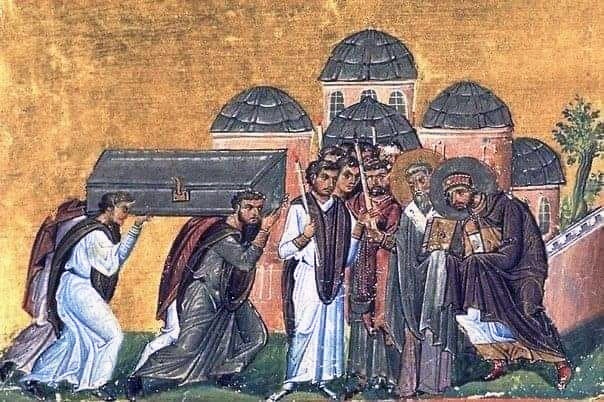Adapted from various sources, including Butler's Lives.
St. Proclus, Archbishop of Constantinople († 447; Feast – October 24)
St. Proclus was a native of Constantinople, and was very young when he was made a lector of that church. The services of the church did not hinder
him from closely pursuing his studies, and he was for some time a disciple of St. John Chrysostom, and his secretary. Archbishop Atticus ordained him deacon and priest.
After his death, many pitched upon St. Proclus as the fittest person to be placed in that important See; but Sissinius was chosen,
who consecrated St. Proclus Archbishop of Cyzicus, metropolis of the Hellespont (Strait of Gallipoli). The inhabitants of that city being unwilling to acknowledge
the jurisdiction of the bishop of Constantinople, refused to receive him, and chose instead Dalmatius, a monk.
 St. Proclus therefore continued at Constantinople, where he earned a reputation for his preaching. Upon the demise of Sisinnius in 427, many again cast their eyes upon
St. Proclus as the most worthy of that dignity; but others alleged that he had been chosen bishop of another See, and that translations (from one See to another)
were forbidden by the canons. Nestorius was then raised to that dignity, and advanced his errors covertly at first, but at length openly.
St. Proclus courageously maintained the truth against him, and in 429 preached a sermon (which is the first among his homilies in print) demonstrating that the
Blessed Virgin Mary ought to be called the Mother of God. Nestorius, who was present, publicly contradicted him in the church.
St. Proclus therefore continued at Constantinople, where he earned a reputation for his preaching. Upon the demise of Sisinnius in 427, many again cast their eyes upon
St. Proclus as the most worthy of that dignity; but others alleged that he had been chosen bishop of another See, and that translations (from one See to another)
were forbidden by the canons. Nestorius was then raised to that dignity, and advanced his errors covertly at first, but at length openly.
St. Proclus courageously maintained the truth against him, and in 429 preached a sermon (which is the first among his homilies in print) demonstrating that the
Blessed Virgin Mary ought to be called the Mother of God. Nestorius, who was present, publicly contradicted him in the church.
When Nestorius was condemned as a heresiarch and deposed in 431, Maximian was chosen to replace him – those that were for St. Proclus being overruled
by the above-mentioned canon; but after Maximian's death in 434, our Saint, who had never been able to take possession of the See of Cyzicus,
was promoted to that of Constantinople. The mildness with which he treated even the most obstinate of the Nestorians, Arians, and other heretics,
was a distinguishing part of his character (Socrat. l. 7, c. 41-42). Nevertheless he strenuously defended the Catholic Faith, and kept up a correspondence
and close union and friendship with the Pope, with St. Cyril of Alexandria, and with John of Antioch.
The Armenian bishops consulted him about the doctrine and writings of Theodorus, Bishop of Mopsuestia, who was then dead,
but whose name was well known in those parts. St. Proclus answered them in 436, by his Tome to the Armenians, which is the most famous of his writings.
In it he condemned the doctrine mentioned as savoring of Nestorianism, and expounded the true doctrine of the Incarnation.
Without naming the deceased Theodorus, he exhorted them to adhere to the doctrine of St. Basil and St. Gregory Nazianzen,
whose names and works were in particular veneration among them. Others carried on this contest with greater warmth,
and some wanted Theodorus, Theodoret, and Ibas to be condemned. John of Antioch wrote to St. Proclus in the same year 436,
against the doctrine of some who seemed to him to confound the two natures in Christ; which error was soon after openly advanced by Eutyches.
The letters of St. Proclus which are extant regard chiefly the disputes of that age concerning the Incarnation, the Blessed Virgin Mary,
whose title of Theotokos – Mother of God – he justly extols, the Mysteries of Christ and the principal feasts of the year. The style of this Father
is concise, sententious, and full of witty turns more proper to please and delight the mind, rather than to move the heart –
therefore it is not to be compared with the easy natural gravity of St. Basil, or the sweet style of St. John Chrysostom.
The first part of the year 447 is memorable for a dreadful earthquake which was felt from place to place, during six months,
in divers parts of Egypt and the East, especially near the Hellespont, and in Bithynia, in Phrygia, and at Antioch in Syria.
The earth shook like a ship abandoned to the mercy of the winds, and tossed by the fury of the waves worked up by a storm.
Amidst the ruins of many stately buildings men ran to and fro almost distracted with fear and horror, not being able to find any place of refuge or security.
At Constantinople the inhabitants wandered in the fields – including the Emperor Theodosius the Younger and his courtiers.
St. Proclus, with his clergy, followed his scattered flock, and ceased not to comfort and exhort them amidst their afflictions,
and to implore the divine mercy with them. The people continually answered by a triple repetition of the prayer: Have mercy on us, O Lord!
Theophanes (Chron. p. 64) and other Greek historians tell us that a child was taken up into the air, and heard angels singing the Trisagion or triple doxology;
which gave occasion to St. Proclus to teach the people to sing it in these words: Holy God, Holy Mighty One, Holy Immortal One, have mercy on us!
(Agios O Theos, Agios Ischyros, Agios Athanatos, eleison imas!) It is at least agreed that St. Proclus with the people used this prayer,
and that thereupon the earthquakes ceased. This Trisagion was inserted by him into the liturgy – it is still used in the Eastern Church,
and in the Roman liturgy on Good Friday (Improperia). The Eastern Church ascribes to St. Proclus the last revision of the liturgies both
of St. John Chrysostom (Constantinople) and of St. James (Jerusalem).
St. Proclus is also credited for the beginning of the process which would eventually lead to the return of the relics of St. John Chrysostom to Constantinople.
During services in the Church of Hagia Sophia, St. Proclus preached a sermon praising St. John Chrysostom. He said, O John, thy life was filled with sorrow,
but thy death was glorious. Thy grave is blessed and thy reward is great, by the grace and mercy of Our Lord Jesus Christ. O favored one,
thou hast conquered the bounds of time and place! Love has conquered space, unforgotten memory has annihilated the limits,
and place does not hinder the miracles of a Saint.
Those who were present in church, deeply touched by the words of St. Proclus,
did not allow him even to finish his sermon. With one accord they began to entreat the Archbishop to intercede with the Emperor,
so that the relics of St. John might be brought back to Constantinople. The Emperor, overwhelmed by St. Proclus,
gave his consent and gave the order to transfer the relics of St. John. But those he sent were unable to lift the holy relics.
Then the Emperor realized that he had sent men to take the saint's relics from Comana with an edict, instead of with a prayer.
He wrote a letter to St. John, humbly asking him to forgive his audacity, and to return to Constantinople. After the message was read at the grave of St. John,
they easily took up the relics, carried them onto a ship and arrived at Constantinople. The coffin with the relics was placed in the Church of Holy Peace (Hagia Eirene).
When St. Proclus opened the coffin, the body of St. John was found to be incorrupt. The Emperor approached the coffin with tears, asking forgiveness for his mother,
who had banished St. John. All day and night people visited the coffin.

Our Saint is styled by St. Cyril, A man full of piety, perfectly skilled in ecclesiastical discipline, and a strict observer of the canons.
Pope Sixtus III gives him the same praises, and Vigilius (St. Ambr. l. 3, de Spir. Sanct. c. 18) calls him the most learned of prelates.
St. Proclus died on October 24 in 447, the same year in which the earthquakes took place. His name is placed in the Greek Menologies and in the Muscovite Calendar;
he is also mentioned briefly in the Roman Martyrology.
How many great, how many learned, how many once holy men have with Nestorius suffered spiritual shipwreck before the end of their course!
At the sight of such examples, who does not tremble for himself? If we know ourselves, we shall be persuaded that no one is weaker and more frail than we are.
Can any creature be more unworthy of the divine mercy than we who have repaid the greatest graces and favors with continual sloth and the basest infidelities?
When, therefore, we read of the fall or sins of others, we ought to turn our eyes upon ourselves; to adore the divine mercy which has still borne with us,
and is yet ready with outstretched arms to embrace us. To shake off our sloth in the practice of virtue, let us enter upon a fervent penitential life,
and call upon God without ceasing in fear and humility. He is our strength and support, Who is almighty and most willing and desirous to save us,
if our willful wretchedness and pride do not stand in the way. He alone can effectually remove these obstacles; humble prayer and compunction will not fail
to obtain this constant grace. To neglect these means is to perish.
Back to "In this Issue"
Back to Top
Back to Saints
Alphabetical Index; Calendar List of Saints
Contact us: smr@salvemariaregina.info
Visit also: www.marienfried.com


 St. Proclus therefore continued at Constantinople, where he earned a reputation for his preaching. Upon the demise of Sisinnius in 427, many again cast their eyes upon
St. Proclus as the most worthy of that dignity; but others alleged that he had been chosen bishop of another See, and that translations (from one See to another)
were forbidden by the canons. Nestorius was then raised to that dignity, and advanced his errors covertly at first, but at length openly.
St. Proclus courageously maintained the truth against him, and in 429 preached a sermon (which is the first among his homilies in print) demonstrating that the
Blessed Virgin Mary ought to be called the Mother of God. Nestorius, who was present, publicly contradicted him in the church.
St. Proclus therefore continued at Constantinople, where he earned a reputation for his preaching. Upon the demise of Sisinnius in 427, many again cast their eyes upon
St. Proclus as the most worthy of that dignity; but others alleged that he had been chosen bishop of another See, and that translations (from one See to another)
were forbidden by the canons. Nestorius was then raised to that dignity, and advanced his errors covertly at first, but at length openly.
St. Proclus courageously maintained the truth against him, and in 429 preached a sermon (which is the first among his homilies in print) demonstrating that the
Blessed Virgin Mary ought to be called the Mother of God. Nestorius, who was present, publicly contradicted him in the church.
